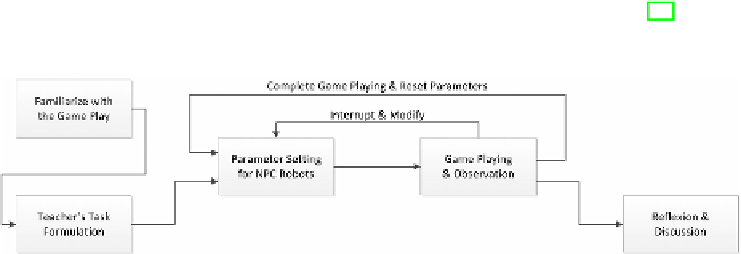Information Technology Reference
In-Depth Information
3.2 Educational Memes in Digital Storyboards
Let us begin with an introductory example adopted and adapted from [27], fig. 3.
Fig. 3.
Storyboarding Extra Game Play and Meta Game Play in
Gorge
Gorge
is some simple browser game (see [19] for the essentials) freely avail-
able on the Internet (see http://www.kindermedien.idmt.fraunhofer.de/gorge/
for the game and [29] for a qualitative study). Both [19] and [29] are provided on
this page for free download. The game runs in English, Japanese and German.
Gorge
bears some potential of playfully learning about Artificial Intelligence.
For playful learning, some taxonomic principles may be invoked [18,21,24].
The two principles explored in [27] are
extra game play
and
meta game play
.
Extra game play means the feature of leaving the game play on purpose before
completion, whereas meta game play means the feature of repeatedly playing
with some purpose in mind. There are several games developed with focus on
one of these or both taxonomic concepts having certain effects of game playing
in mind [18].
The two loops backward in figure 3 illustrate the way in which extra game play
and meta game play, resp., is anticipated in contextual game play of
Gorge
.
The two nested loops on display in figure 3 form (an instance of) some meme.
The related storyboard sub-structure might be seen as some meme media object.
For reuse in another storyboard, it may be copied and modified to meet the
peculiar needs of the new application under consideration.
For the practical deployment of meme media technology in storyboarding
educational processes, it is fundamental to have media objects which may be
literally picked up for (re-)use, thus, becoming subject to direct manipulation [44]
or, even further, to direct execution [13]. When pondering what other authors
call didactic models [12] or educational patterns [42], it is decisive to find ways
of digitally encapsulating ideas which might be considered memes.
Following the introductory example above, let us now undertake an attempt
to use one of the so-called pedagogical patterns of [42]. “Built-In Failure” is
said to be a pedagogical pattern (ibid., pp. 25-26). There is the obvious, though
rather general motivation that “learning comes from experience, and much useful
experience comes from failure. but a learner who lacks confidence will fear failure,
and this fear impedes or even prevents learning.”













